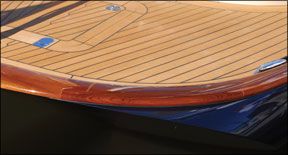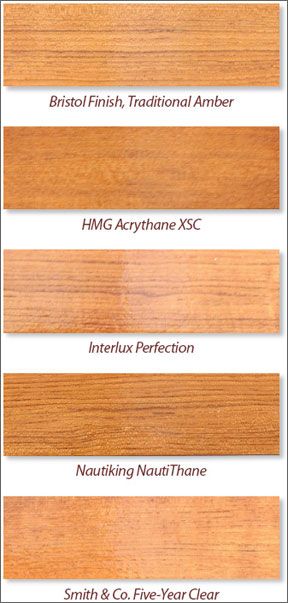The two-part varnish test launch is the third installment of an ongoing report on our marine exterior wood coatings test, which began with an introduction to one-part varnishes (August 2007), followed by our synthetics and wood stains review (October 2007). The two-part teak coatings being tested are the Bristol Finish Traditional Amber, Smith & Co.s Five-Year Clear, HMG Paints Acrythane XSC, Interluxs Perfection, and Bonstones Nautiking NautiThane.
****
In our first exterior coatings report this year (August 2007), we described our ideal coating as one that is “fast and easy to apply for even the novice brightwork nurse … easy to maintain, lasts for multiple seasons, and wont break the bank.”
Most two-part varnishes don’t fit the bill-at least not entirely. Compared to other wood coatings, most are neither easy to apply nor easy to maintain. However, they do last for several seasons, and pricewise, they are on par with other wood coatings.
Ralph Naranjo

Their appeal is generally durability and the glossy, wet look they have when applied properly. “The Look” is that beautiful, clear mirror-like finish. For some, this aesthetic value, coupled with the luxury of not having to reapply the finish for several seasons, is worth the extra time, energy, and attention that applying a typical two-part varnish requires.
And it is for those brightwork slaves among us that we have included five two-part varnishes in our exterior wood coatings test-plus were curious to see just how well they fare when compared to one-part varnishes, synthetics, and stains under the same conditions. Are they really more durable? Do they protect better than other coatings? Is the difference worth the pains of application-and just as importantly, re-application?
This is the third installment of an ongoing report on our exterior wood coatings test, which began with an introduction to one-part varnishes (August 2007), followed by our synthetics and stains review (October 2007). Still to come isPractical Sailors report on the teak oils were testing.
With more than 50 products to compare,Practical Sailor opted to split the products into categories, so the information is a bit easier to digest. However, all of the test panels have been mounted and will face the same conditions in our longterm durability test, and all will be monitored regularly.
What We Tested

Practical Sailortested five two-part varnishes for the exterior coatings showdown: Bristol Finish Traditional Amber, Smith & Co.s Five-Year Clear, HMG Paints Acrythane XSC, Interluxs Perfection, and Bonstones Nautiking NautiThane. Of those, the Bristol and Smith & Co. are returning contestants from our 2003-2005 Teak Treatments All-Stars face-off (finale, Feb. 15, 2005). However, Bristol changed its formula in March 2003, so the product we are testing now is not the same as the Bristol in the previous test. According to its makers, the new formula has increased durability, a slower dry time for brushability, and a faster cure time.
C-Tech Marine, the maker of Bristol Finish, offers three application methods to choose from: the wet-on-wet method, dry method, and the practical method. We used (surprise) the practical method (see chart for specifics), which entailed very little sanding, making Bristol the easiest of the two-parts to apply.
HMG Paints, a European company with a branch in the U.S., produces a number of wood coatings, including its Acrythane XSC. This polyurethane didnt flow evenly at first, but by the second and third coats, the finish was smooth and even.
Perfection, from coatings giant Interlux, is a linear polyester. Our Perfection test panel had the best initial gloss of the two-parts. To maintain this top gloss, Interlux recommends sanding the finish with a maroon Scotch-Brite pad and applying a fresh coat at regular intervals.
Nautiking NautiThane, a new coating by adhesives maker Bonstone, was the fastest drying of the test group.
Testers found the Smith & Co. Five-Year Clear to be the most time-consuming to apply, but also the smoothest to flow on. Applying the required three coats of epoxy sealer added steps to the process, but it also made the varnish application balanced. The product is only sold factory direct to the user; you cannot buy it in a store or from any online chandlery. Also, Smith & Co. is the only coatings maker that we are aware of that requires its customers to pass an application “checkout” after reading the products instructions and before applying it. While we can appreciate the companys efforts to ensure correct application and its personal attention to each customer, having to pass a test to buy varnish is an odd concept, in our opinion. In a further effort to guard against improper application, Steve Smith (president of Smith & Co.) requested that we not list a per-quart-price for the product or a suggested number of coats to apply. Smith said “that opens the door to misapplication.”
Smith did tell us that he recommends a dry film thickness (DFT), measured with a micrometer, of 10 mils. In comparison, Interlux recommends a DFT of 6-8.5 mils, which can be achieved with five to seven coats of the Perfection.
Two-Part Coatings
Along with the how-tos of varnish application, the use of two-part varnishes always draw a debate among boaters. Are they worth the effort or arent they? The answer largely depends on your taste in finish, your approach to boat maintenance, your patience level, your deftness with a brush, and your tolerance for a heat gun and scraper.
Two-parters come with a bevy of contradictions. It seems for every pro, there is a con: They offer a tougher, more abrasion-resistant finish than other flavors of wood coatings, but this hard finish is difficult to sand for touch-ups without leaving ghastly scratches in the finish. They provide a good moisture barrier for wood, but this can lead to blistering when water migrates upward through fastener holes. Most dry fast, shortening the recoat wait, but that quick-dry feature also means you better brush it on quickly or risk brush marks in the finish.
They are durable and, with regular attention, can last for several seasons. However, once the varnish goes south, break out the scraper and heat gun, because youll never get it all off with sandpaper.
Ahhh, but then theres that beautiful, durable shine. Well that same clear gloss will highlight each and every imperfection in the prep work as well as any runs, holidays, or other application boo-boos. So, don’t rush the job, any hiccup will haunt you later; but don’t be too slow, youre on a timer as all two-parts have a set potlife.
Another two-part-related topic that incites opinionated discussion is whether or not using epoxy as a base coat is a good idea. One product we tested, Smith & Co.s Five-Year Clear, instructed us to do just that. We applied three coats of Smiths Clear Penetrating Epoxy Sealer on bare wood and then the two-part varnish. The result was the appearance of a thicker (deeper) layer of varnish than other test products offer using about the same number of coats.
Interluxs Jim Seidel, a veteran of the coatings industry, is also a fan of epoxy build-up coats (using Epiglass, West Systems, Smiths, etc.). He suggests thinning the first epoxy coat to ensure penetration into the wood. While epoxy adds durability and makes buildup faster, it does not have any UV protection, so applying varnish over it is a must.
Conclusion
So how do the pros and cons weigh out? Differently for each boat owner. Evaluating your needs and your priorities will help you decide whether a two-part product is right for your boat. If youre not too handy with a brush-or a heat gun and scraper-then we suggest staying away from clear two-part varnishes.
However, if you want a hard finish for your toe rail and like to admire your reflection in your handiwork, then by all means, break out the mixing cups and a good brush.
All of the two-parts we tested rated Good or better in both gloss and application (when compared to each other, not other varieties of exterior coatings). Our top pick among two-parts, so far, is the Bristol Finish as it was the easiest to apply and had an Excellent gloss. The Smith had Excellent gloss and went on nicely, but its time-consuming application and single-source supply holds it back. The Perfection also passed muster among our testers. The cheapest per quart is NautiThane, and the cheapest kit is the Acrythane.
Stay tuned to see just how well these products protect wood for the long haul.






































How/can you touch up blisters in Bristol two part varnish (if so how) or must you strip the entire piece of teak rail ? Thanks for any help, I have a Hans Christion 38 and need all the understanding I can get.